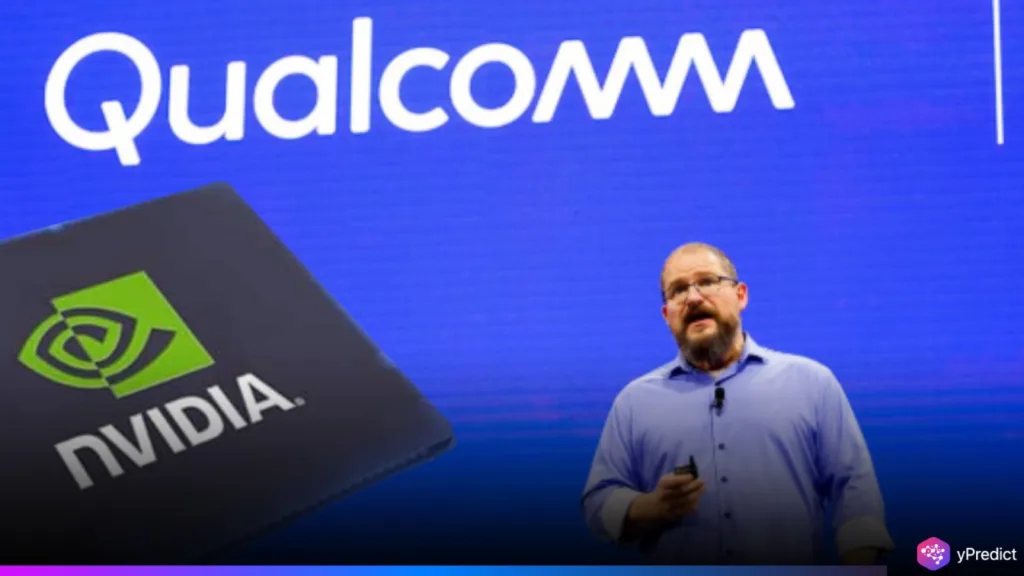
Qualcomm Inc. is building CPUs that will directly interface with Nvidia’s industry-leading AI chips via the high-speed NVLink interconnect. Qualcomm announced this move on May 19, 2025, positioning it to compete in the rapidly expanding AI infrastructure area, where demand for high-performance, energy-efficient computing is increasing.
The partnership will enable seamless GPU-CPU connectivity for AI applications, providing an alternative to Intel and AMD’s existing solutions. Qualcomm’s comeback marks a renewed commitment to enterprise computing, this time with an edge designed for the AI-driven future of data centres.
A Strategic Play in the Expanding AI Infrastructure Space
According to an early morning report by CNBC, Qualcomm has announced its return to the data centre processor industry, revealing plans to create custom central processing units (CPUs) that will integrate smoothly with Nvidia’s cutting-edge artificial intelligence (AI) chips.
This decision represents a significant strategic shift for Qualcomm, as it seeks to establish a competitive presence in a market long controlled by Intel and AMD.
Nvidia’s GPUs already dominate AI computing, powering large language models and real-time inference engines across various applications and industries. However, modern GPUs still depend on high-performance CPUs to operate efficiently in demanding AI workloads and data processing tasks.
Nvidia previously paired its GPUs with in-house CPUs like the Arm-based “Grace” chip for optimal performance and integration. Now, through this collaboration, Qualcomm will use Nvidia’s NVLink technology to connect its custom CPUs directly with Nvidia’s AI hardware.
This renewed emphasis on data centre hardware comes after Qualcomm departed the sector in the late 2010s due to financial restrictions and regulatory problems. At the time, the business had started producing Arm-based CPUs and had even run tests using Meta Platforms. However, those attempts were put on hold.
In 2021, Qualcomm acquired Nuvia, a startup founded by former Apple semiconductor engineers, reigniting its ambitions in CPU development. The acquisition brought technical expertise and fresh momentum, positioning Qualcomm to re-enter a competitive market seeking high-performance, energy-efficient alternatives. CEO Cristiano Amon announced plans to unveil a roadmap for these new chips, promising innovation and disruption in the CPU space. In a statement, he said:
As long as … we can build a great product, we can bring innovation, and we can add value with some disruptive technology, there’s going to be room for Qualcomm, especially in the data center. [It] is a very large addressable market that will that will see a lot of investment for decades to come.
Qualcomm’s AI-Focused CPUs Will Target Next-Gen Data Centers
Qualcomm is set to launch new Arm-based chips for data centers, focusing on energy efficiency and high AI performance capabilities. These processors aim to challenge traditional x86 CPUs by reducing power consumption and integrating seamlessly with Nvidia’s advanced AI GPUs. The combination offers strong advantages for handling demanding AI workloads across modern data infrastructure and enterprise applications.
Apart from this, Qualcomm has also signed a memorandum of understanding with Humain, a Saudi AI firm backed by the Public Investment Fund, to co-develop custom CPUs for hyperscale data centers. Analysts see this as a strong indication of Qualcomm’s renewed commitment to high-performance computing and next-generation AI infrastructure.
Conclusion
Qualcomm’s strategic return to the data center CPU market, supported by Nvidia, marks a pivotal moment in AI infrastructure development. With direct NVLink connectivity, Qualcomm meets rising demand for scalable, high-performance AI processing in increasingly complex enterprise environments.
As businesses demand integrated, efficient hardware, Qualcomm’s strategy challenges incumbents and reinforces its position in future data center ecosystems. Its collaboration with Nvidia improves chip compatibility and reflects a wider industry move toward AI-optimized, heterogeneous computing for modern workloads.






